Wednesday 29
November 2006
We take the 8.30am train from Rotterdam
to Amsterdam Airport Schiphol, where arive at 9.15. We have already checked in
for our Lufthansa flight
via the 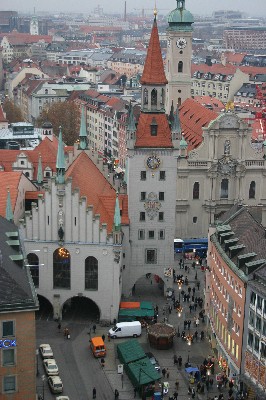 Internet,
but at Lufthansa you are not allowed to print your own boarding pass. That
should be done at a machine at the airport itself. Communicating with that thing
is not as easy as it should be (especially when you travel with more than one
person on the same booking) and we almost leave with just one boarding pass and
a printed itinerary. We discover our mistake just in time and a counter clerk is
able to put things right. We fly with a small aircraft (an AVRO) to Munich
in about 5 quarters of an hour. There we take the S-bahn (regional
railway) in to the city. 45 minutes later we get off the train at the Isartor
stop from where we walk to the (gay)
hotel Deutsche Eiche.
Our Komfort Doppelzimmer (comfort double) is ready and we make ourselves
comfortable. We have lunch in the hotel's restaurant before go into town. We are
about a 100 yards from the Viktualienmarkt (daily food market) and the
Marienplatz square, where the Neue Rathaus (town hall) can be found. Internet,
but at Lufthansa you are not allowed to print your own boarding pass. That
should be done at a machine at the airport itself. Communicating with that thing
is not as easy as it should be (especially when you travel with more than one
person on the same booking) and we almost leave with just one boarding pass and
a printed itinerary. We discover our mistake just in time and a counter clerk is
able to put things right. We fly with a small aircraft (an AVRO) to Munich
in about 5 quarters of an hour. There we take the S-bahn (regional
railway) in to the city. 45 minutes later we get off the train at the Isartor
stop from where we walk to the (gay)
hotel Deutsche Eiche.
Our Komfort Doppelzimmer (comfort double) is ready and we make ourselves
comfortable. We have lunch in the hotel's restaurant before go into town. We are
about a 100 yards from the Viktualienmarkt (daily food market) and the
Marienplatz square, where the Neue Rathaus (town hall) can be found.
At the Marienplatz square we start our
walk. The Christkindlmarkt
(Christmas market) is due to start in two days and preparations are well under
way. The most striking building on Marienplatz is the
Neues Rathaus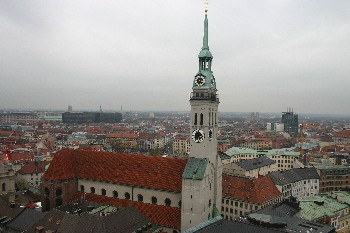 (1867-1908) or town hall. For its construction a number of old country houses
had to be torn down. The architect Von
Hauberrisser took a close look at Brussels' gothic town hall for inspiration.
This one, however, is more richly decorated, but for that reason less balanced
than its Belgian example. We climb the town hall tower (by elevator) and enjoy
the view. It is rather overcast and we are not able to see the Alps from
here today, but we get a good view of the city. It cold and humid and up there
it is quite windy too. We go down again to take a closer look at the Peter
church opposite, unsurprisingly dedicated to St Peter. The church was,
as so many other buildings in the city, heavily damaged during the Second World
War, and reconstructed after the
(1867-1908) or town hall. For its construction a number of old country houses
had to be torn down. The architect Von
Hauberrisser took a close look at Brussels' gothic town hall for inspiration.
This one, however, is more richly decorated, but for that reason less balanced
than its Belgian example. We climb the town hall tower (by elevator) and enjoy
the view. It is rather overcast and we are not able to see the Alps from
here today, but we get a good view of the city. It cold and humid and up there
it is quite windy too. We go down again to take a closer look at the Peter
church opposite, unsurprisingly dedicated to St Peter. The church was,
as so many other buildings in the city, heavily damaged during the Second World
War, and reconstructed after the 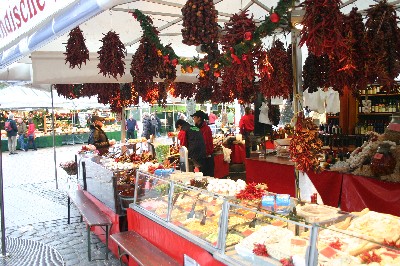 war.
The church has a beautiful gold plated altar. We continue over the Marienplatz
and go past the Alte Rathaus (old town hall), that serves as the Toy
Museum these days.The building was not completely restored. Only its tower and
council hall were built up again. Behind the building is the Heiliggeistkirche
(holy spirit church). The church has a rather austere interior. We then move
on through the Viktualienmarkt. This daily fresh food market is
heavily visited by consumers and chefs alike. You find everything here: fish,
meat, venison, vegetables, delicacies and this time of year also Christmas
decorations. We walk on via
Rosental and Oberanger in the direction of Sendlingerstrasse, where the Asamkirche
can be found. Officially it is called the war.
The church has a beautiful gold plated altar. We continue over the Marienplatz
and go past the Alte Rathaus (old town hall), that serves as the Toy
Museum these days.The building was not completely restored. Only its tower and
council hall were built up again. Behind the building is the Heiliggeistkirche
(holy spirit church). The church has a rather austere interior. We then move
on through the Viktualienmarkt. This daily fresh food market is
heavily visited by consumers and chefs alike. You find everything here: fish,
meat, venison, vegetables, delicacies and this time of year also Christmas
decorations. We walk on via
Rosental and Oberanger in the direction of Sendlingerstrasse, where the Asamkirche
can be found. Officially it is called the 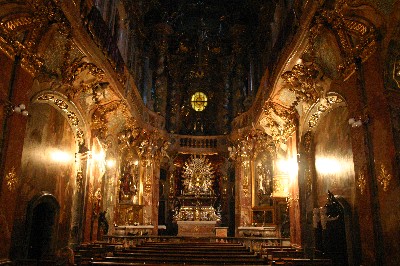 Nepomuk
church, but it is better known by the name of its creators the Asam brothers.
They designed lots of churches during the 18th century in both Munich and
Bavaria. All of them richly decorated in rococo style. They play a game with
convex and concave lines. This church was financed by the brothers themselves
and built on their own plot. This as a thanks for being saved from a drowning
accident on the Danube. The church facade is part of the street front together
with residential buildings next to it. Inside we are startled by the gold plated
decorations, paintings, frescoes and statues. Nepomuk
church, but it is better known by the name of its creators the Asam brothers.
They designed lots of churches during the 18th century in both Munich and
Bavaria. All of them richly decorated in rococo style. They play a game with
convex and concave lines. This church was financed by the brothers themselves
and built on their own plot. This as a thanks for being saved from a drowning
accident on the Danube. The church facade is part of the street front together
with residential buildings next to it. Inside we are startled by the gold plated
decorations, paintings, frescoes and statues.
After this religious bombardment we go
for coffee in the Starbuck's opposite. At night we eat at Morizz
close to our hotel. This is a trendy bar-restaurant with a mix of Thai and
German cuisne. Later that night we sample the local gay scene. It is remarkably
busy for a Wednesday night.
Weather: overcast 8°C
Thursday 30 November 2006
After breakfast we walk towards
Marienplatz again. We drink coffee with cake in a Konditorei (German tea room).
After that we go and buy a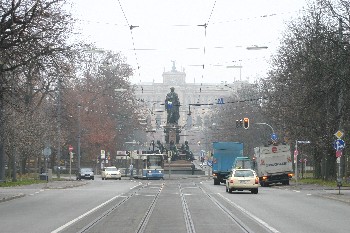 Munich
Welcome card at the Tourist Information inside the town hall. It entitles
us to 3 days of unlimited travel (central part) and discounts for a number of
attractions. We start today's walk and make for the Alter Hof (Old Courtyard).
This square once played an important role in Bavarian court life, but was
heavily damaged during the war. It has been rebuilt, but it makes a unfinished
impression. A few blocks away is the famous Hofbräuhaus,
the most known of the Munich beer cellars. This early in the day it looks
deserted. We will be back!!! We head for the Maximilianstraße op, the swishest
shopping street in the city. All the famous fashion and jewelry brands have
their own stores. The streets starts at the National Theatre and continues to
the Maximilaneum, where the Bavarian parliament (Landtag)
gathers. It was built as a palace for Maximilian II between 1857 and 74. On this
street we also see the Münchner
Kammerspiele or Schauspielhaus, a well known theatre in Art Nouveau
style. Unfortunately it is closed to visitors. We continue down the street
towards the Max-Josephplatz where the Residenz
is located. This
Munich
Welcome card at the Tourist Information inside the town hall. It entitles
us to 3 days of unlimited travel (central part) and discounts for a number of
attractions. We start today's walk and make for the Alter Hof (Old Courtyard).
This square once played an important role in Bavarian court life, but was
heavily damaged during the war. It has been rebuilt, but it makes a unfinished
impression. A few blocks away is the famous Hofbräuhaus,
the most known of the Munich beer cellars. This early in the day it looks
deserted. We will be back!!! We head for the Maximilianstraße op, the swishest
shopping street in the city. All the famous fashion and jewelry brands have
their own stores. The streets starts at the National Theatre and continues to
the Maximilaneum, where the Bavarian parliament (Landtag)
gathers. It was built as a palace for Maximilian II between 1857 and 74. On this
street we also see the Münchner
Kammerspiele or Schauspielhaus, a well known theatre in Art Nouveau
style. Unfortunately it is closed to visitors. We continue down the street
towards the Max-Josephplatz where the Residenz
is located. This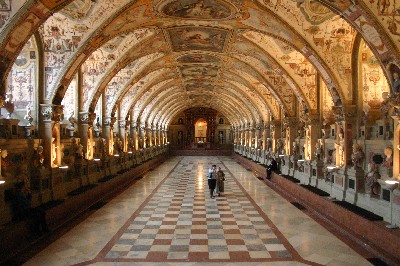 is
the most important palace in the city of the royal family Wittelsbach. It was
the royal residence from 1508 until 1918 when Bavaria became a republic. We get
a Euro discount with our Welcome card. The complex consists of distinct parts:
the Königsbau (King's quarters), the Alte Residenz (Old Residence) and the
Festsaalbau (Party Quarters). There are 130 rooms of which 70 are open to the
public at any one time and to be visited vai a signposted route. Equipped with a
Audiotour device we wander through the immense spaces. We come through beautiful
rooms, anterooms, ball rooms, bed rooms.. you name it. No cost was spared to
build these quarters, made to impress. We do not notice that the signposted
route changes around midday to make the other 70 rooms available to visitors.
This makes the route seem endless and it forces us to see some of them twice. We
are almost exhausted when we reach teh exit. We leave the Treasury for a later
date. is
the most important palace in the city of the royal family Wittelsbach. It was
the royal residence from 1508 until 1918 when Bavaria became a republic. We get
a Euro discount with our Welcome card. The complex consists of distinct parts:
the Königsbau (King's quarters), the Alte Residenz (Old Residence) and the
Festsaalbau (Party Quarters). There are 130 rooms of which 70 are open to the
public at any one time and to be visited vai a signposted route. Equipped with a
Audiotour device we wander through the immense spaces. We come through beautiful
rooms, anterooms, ball rooms, bed rooms.. you name it. No cost was spared to
build these quarters, made to impress. We do not notice that the signposted
route changes around midday to make the other 70 rooms available to visitors.
This makes the route seem endless and it forces us to see some of them twice. We
are almost exhausted when we reach teh exit. We leave the Treasury for a later
date.
We head for some lunch at Zum
Franziskaner. It is a traditional diner where we share a big table
with several others. People from all walks of life keep coming and going. We
have a Kasseler Riprl vom Rost mit Kartoffelsalat (Grilled pork
chop with patatoe salad. 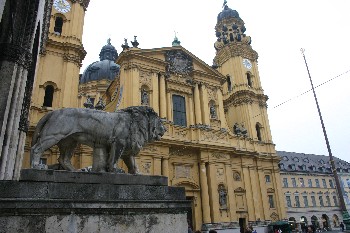 Accompanied with a basket of Brezn (salted pretzels), which we – as it
turns out – have to pay for per piece consumed. Most of the guest wash down
their meal with pints (or more) of beer.
Accompanied with a basket of Brezn (salted pretzels), which we – as it
turns out – have to pay for per piece consumed. Most of the guest wash down
their meal with pints (or more) of beer.
Filled and contented as we are, we continue our walk and
arrive at the Theatiner church and the Feldhernhalle on
Odeonsplatz. De
17th century church with its yellow facade and its dome makes an Italian
impression. That is where its Italian architect Barelli comes from. Inside the
rococo church is entirely white stucco and relatively austere. Statues and
stucco are typically 18th century and rich in detail. The Feldhernhalle is a logia
from 1842 after a Florentine example with statues representing Bavarian
generals. It was commisioned by king Ludwig I. It served as a backdrop for
gatherings and parades during the Nazi period.
We continue along the Ludwigstrasse and
see the Siegestor (triumphal arc) from 1850 in the distance. It was inspired by Constantine's
Arc in Rome. We turn right into the Von der Tann straße and walk towards theEnglischer Garten.
This 19th century park covers a large area (350 ha) where all of Munich
comes to rest and play during summer. It is cold now, but there are still quite
a number of strollers and runners. At the edge of the park we see the austere
classical Haus der Kunst (House of Art), where Hitler had "good
national" art exhibited. Later it functioned as a museum for modern art,
but that role has been filled now by the Pinakothek der Moderne.
We take the underground to the new
football temple of Munich. For the 2006 World Cup Munich built a new stadium:
the 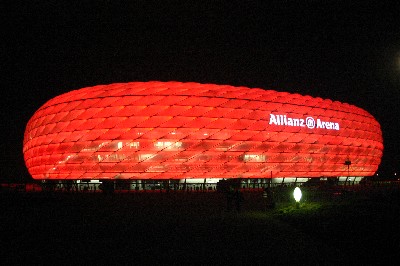 FIFA WM
stadion, which continued since as the Allianz
Arena and serves as a home base for FC Bayern München and TSV 1860
München, the two professional football teams of the city. The stadium is
located at the edge of town and has a very special design. It consists of three
rings and the outside is covered with synthetic air cushions, which can be
illuminated in Red (Bayern), Blue (1860) or White (neutral). It can hold 66.000
spectators. We get a tour (one Euro discount with Welcome Card) and get a
look back stage, including the dressing rooms, where can admire the
lockers of our 'own' Dutch lads Roy Makaay and Mark van Bommel. FIFA WM
stadion, which continued since as the Allianz
Arena and serves as a home base for FC Bayern München and TSV 1860
München, the two professional football teams of the city. The stadium is
located at the edge of town and has a very special design. It consists of three
rings and the outside is covered with synthetic air cushions, which can be
illuminated in Red (Bayern), Blue (1860) or White (neutral). It can hold 66.000
spectators. We get a tour (one Euro discount with Welcome Card) and get a
look back stage, including the dressing rooms, where can admire the
lockers of our 'own' Dutch lads Roy Makaay and Mark van Bommel.
Back in the city we have a break before we had for Dinner in the stylish
restaurant Ederer. We
choose the wine menu wine the wine arrangement. The food is deleicious: Pata
Negra, Langoustines and Coquilles, Veal shoulder and Apple crêpes for desert.
Weather:
foggy . 7°C.
|